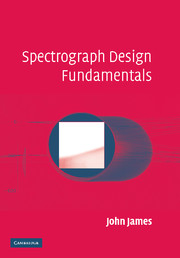Book contents
- Frontmatter
- Contents
- Preface
- Acknowledgements
- 1 A brief history of spectroscopy
- 2 The relevant regions of the electromagnetic spectrum
- 3 Geometrical optics
- 4 Optical aberrations
- 5 Fourier transforms: a brief revision
- 6 Physical optics and diffraction
- 7 The prism spectrograph
- 8 The plane grating spectrograph
- 9 The concave grating spectrograph
- 10 The interference spectrograph
- 11 The multiplex spectrometer
- 12 Detectors
- 13 Auxiliary optics
- 14 Optical design
- 15 Mechanical design and construction
- 16 Calibration
- 17 The alignment of a spectrograph
- Appendix 1 Optical aberrations
- Appendix 2 Wavelengths of spectral lines for calibration
- Appendix 3 The evolution of a Fabry–Perot interference spectrograph
- Appendix 4 The common calibration curve in silver halide spectrophotometry
- Bibliography
- Index
12 - Detectors
Published online by Cambridge University Press: 02 September 2009
- Frontmatter
- Contents
- Preface
- Acknowledgements
- 1 A brief history of spectroscopy
- 2 The relevant regions of the electromagnetic spectrum
- 3 Geometrical optics
- 4 Optical aberrations
- 5 Fourier transforms: a brief revision
- 6 Physical optics and diffraction
- 7 The prism spectrograph
- 8 The plane grating spectrograph
- 9 The concave grating spectrograph
- 10 The interference spectrograph
- 11 The multiplex spectrometer
- 12 Detectors
- 13 Auxiliary optics
- 14 Optical design
- 15 Mechanical design and construction
- 16 Calibration
- 17 The alignment of a spectrograph
- Appendix 1 Optical aberrations
- Appendix 2 Wavelengths of spectral lines for calibration
- Appendix 3 The evolution of a Fabry–Perot interference spectrograph
- Appendix 4 The common calibration curve in silver halide spectrophotometry
- Bibliography
- Index
Summary
In spectrography, where spatial resolution is required, there is a clear subdivision in detection technology between photochemical and photoelectric methods. So far as chemical methods are concerned they possess few advantages over photoelectric methods except possibly for observations at remote sites where a reliable supply of electricity is uncertain or unavailable. They comprise the reduction of silver halide salts to colloidal silver in a solid emulsion coated on to glass or on to a transparent flexible substrate. The detective quantum efficiency (DQE) of silver halide crystals is in the region of 10–4–10–3, the dynamic range is in the region of 100:1 and as photodetectors they are severely non-linear in response, especially where long recording times – greater than 100 s – are involved. ISO ratings, usually quoted in the range of 12 for high-resolution fine-grain emulsions, to 2000 at the higher end of the range for severely coarse high-γ high-sensitivity emulsions, fall rapidly at exposures longer than 10–30 s. The effect, known as ‘reciprocity failure’, is the notion that the blackening produced depends solely on the product of intensity and time and is a necessary assumption if spectrophotometry is to be done.
This sensitivity range may be compared with a liquid-nitrogen cooled CCD detector with a DQE in the region of 0.5 and strict linearity over a dynamic range of 25 000:1, a sensitivity broadly equivalent to an ISO of 3 × 106. Liquid-nitrogen cooled CCD detectors require far more careful screening from light than silver halide emulsions.
- Type
- Chapter
- Information
- Spectrograph Design Fundamentals , pp. 120 - 127Publisher: Cambridge University PressPrint publication year: 2007



